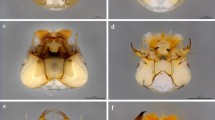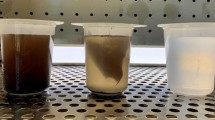Abstract
Predators with complex life cycles often differ in their morphology, behavior, and trophic position across their ontogeny, and may thus have variable effects on shared prey. We used the predaceous diving beetle Laccophilus fasciatus rufus as our predator, whose larvae and adults often co-occur in freshwater lentic systems. As a shared prey we used early and late instar Culex quinquefasciatus, a common wetland mosquito. We found that single adult predators were more likely to consume late instar prey compared to juvenile predators, who ate early and late instar prey equally. A mixture of juvenile and adult predator stages led to higher consumption of prey when compared to either predator type alone. Adult dytiscids consumed three times as many dead prey compared to living ones, thus implying a role in scavenging for this life-history stage. Our work highlights that predators with complex life-history stages may affect shared prey in complicated and unpredictable ways.



Similar content being viewed by others
References
Aditya, G. & G. K. Saha, 2006. Predation of the beetle Rhantus sikkimensis (Coleoptera: Dytiscidae) on the larvae of Chironomus Meigen (Diptera: Chironomidae) of the Darjeeling Himalayas of India. Limnologica 36: 251–257.
Aditya, G., A. Ash & G. K. Saha, 2006. Predatory activity of Rhantus sikkimensis and larvae of Toxorhynchites splendens on mosquito larvae in Darjeeling, India. Journal of Vector Borne Disease 43: 66–72.
Alto, B. W., J. Malicoate, S. M. Elliott & J. Taylor, 2012. Demographic consequences of predators on prey: trait and density mediated effects on mosquito larvae in containers. PLoS ONE 7: 1–8.
Batzer, D. P. & S. A. Wissinger, 1996. Ecology of insect communities in nontidal wetlands. Annual Review of Ecology and Systematics 41: 75–100.
Bosi, G., 2001. Abundance, diversity and seasonal succession of dytiscid and noterid beetles Coleoptera: Adephaga in two marshes of the Eastern Po Plain Italy. Hydrobiologia 459: 1–7.
Brogdon, W. G. & J. C. McAllister, 1998. Insecticide resistance and vector control. Emerging Infectious Diseases 4: 605–613.
Chandra, G., S. Mandal, A. Ghosh, D. Das, S. Banerjee & S. Chakraborty, 2008. Biocontrol of larval mosquitoes by Acillus sulcatus (Coleoptera: Dytiscidae). BMC Infectious Diseases 8: 138–145.
Clements, A. N., 1999. The Biology of Mosquitoes, Vol. II. Chapman & Hall, London.
Culler, L. & W. Lamp, 2009. Selective predation by larval Agabus (Coleoptera: Dytiscidae) on mosquitoes: support for conservation-based mosquito suppression in constructed. Freshwater Biology 54: 2003–2014.
Culler, L., S. Ohba & P. Crumrine, 2014. Predator-prey interactions of dytiscids. In Yee, D. A. (ed.), Ecology, systematics, and the natural history of predaceous diving beetles (Coleoptera: Dytiscidae). Springer, London: 364–386.
Deding, J., 1988. Gut content analysis of diving beetles (Coleoptera: Dytiscidae). Natura Jutlandica 22: 17–184.
Formanowicz, D., 1982. Foraging tactics of larvae of Dytiscus verticalis Coleoptera: Dyticidae: the assessment of prey sensity. Journal of Animal Ecology 51: 757–767.
Fretwell, S. D., 1987. Food-chain dynamics-the central theory of ecology. Oikos 50: 291–301.
Hagen, K., S. Bombosch & J. A. McMurtry, 1976. The biology and impact of predators. In Huffaker, C. B. (ed.), Theory and Practice of Biological Control. Academic Press, New York: 93–142.
Hicks, B., 1994. Foregut contents of adult Ilybius erichson Dytiscidae: Coleoptera from Newfoundland. Coleopterist Bulletin 48: 199–200.
Johnson, J., D. Saenz, C. K. Adams & R. Connor, 2003. The Influence of predator threat on the timing and life-history switch point: predator-induced hatching in the southern leopard frog (Rana sphenocephala). NRC Canada 81: 1608–1613.
Kehl, S. & K. Dettner, 2003. Predation by pioneer water beetles Coleoptera, Dytiscidae from sand pit ponds, based on crop-content analysis and laboratory experiments. Archiv fur Hydrobiologie 1: 109–126.
Kern W. H., 2004. Some small native freshwater fish recommended for mosquito and midge control in ornamental ponds. ENY-670 Department of Entomology and Nematology, UF/IFAS Extension: 1–4.
Klecka, J. & D. Boukal, 2012. Who eats whom in a pool? A comparative study of prey selectivity by predatory aquatic insects. PLoS ONE 7: 1–13.
Larson, D. J., Y. Alarie & R. E. Roughley, 2000. Predaceous Diving Beetles Coleoptera: Dytiscidae of the Nearctic Region. NCR Research Press, Ottawa.
Lundkvist, E., J. Landin, M. Jackson & C. Svensson, 2003. Diving beetles Dytiscidae as predators of mosquito larvae Culicidae in field experiment and in laboratory tests of prey preference. Bulletin of Entomological Research 93: 219–226.
McCoy, M. W., M. Barfield & R. D. Holt, 2009. Predator shadows: complex life histories as generators of spatially patterned indirect interactions across ecosystems. Oikos 118: 87–100.
Nilsson, A. N. & O. Söderström, 1988. Larval consumption rates, interspecific predation, and local guild composition of egg-overwintering Agabus (Coleoptera: Dytiscidae) species in vernal pools. Oecologia 76: 131–137.
Ohba, S., 2009. Ontogenetic dietary shift in the larvae of Cybister japonicus Coleoptera: Dytiscidae in Japanese rice fields. Environmental Entomology 38: 856–860.
Ohba, S. & M. Ushio, 2015. Effect of water depth on predation frequency by diving beetles on mosquito larvae prey. Entomological Science 18: 519–522.
Payne, L. X. & J. W. Moore, 2006. Mobile scavengers create hotspots of freshwater productivity. Oikos 115: 69–80.
Pitcher, K. A. & D. A. Yee, 2014. Habitat use, prey consumption, and dispersal responses as potential coexistence mechanisms using two morphologically similar species of predaceous diving beetles (Coleoptera: Dytiscidae). Annals of the Entomological Society of America 107: 582–591.
SAS Institute. 2004. SAS/STAT Users Guide, Version 6, 4th ed., vol. 1 and 2. SAS Institute, Cary, NC
Savino, J. & R. Stein, 2011. Predator-Prey interaction between largemouth bass and bluegills as influenced by stimulated, submersed vegetation. Transactions of the American Fisheries Society 3: 255–266.
Schmitz, O. J., 2007. Predator diversity and trophic interactions. Ecology 88: 2415–2426.
Shaalan, A.-S. & D. V. Canyon, 2009. Aquatic insect predators and mosquito control. Tropical Biomedicine 26: 223–261.
Thakare, V. G. & V. S. Zade, 2011. Diversity, abundance and species composition of water beetles Coleoptera: Dytiscidae, Hydrophilidae and Gyrinidae in Kolkas Region of Melghat Tiger Reserve, Central India. Academic Journal of Entomology 4: 64–71.
Velasco, J. & A. Millan, 2008. Feeding habits of two large insects from a desert stream: Abedus herberti (Hemiptera: Belostomatidae) and Thermonectus marmoratus (Coleoptera: Dytiscidae). Journal of Entomology 4: 64–71.
Vinogradova, E. B., 2000. Culex pipiens pipiens Mosquitoes: Taxonomy, Distribution, Ecology, Physiology, Genetic, Applied Importance and Control. Pensoft publishers, Sofia.
Wilbur, H., 1980. Complex life cycles. Annual Review of Ecology and Systematics 11: 67–93.
Yee, D. A., 2010. Behavior and aquatic plants as factors affecting predation by three species of larval predaceous diving beetles (Coleoptera: Dytiscidae). Hydrobiologia 637: 33–43.
Young, A. M., 1967. Predation in larvae of Dytiscus marginalis Linneaus (Coleoptera: Dytiscidae). Pan Pacific Entomology 43: 113.
Acknowledgements
We thank S. Schelble, N.F. Ezeakacha, and W.C. Glasgow for assistance in the laboratory. This work was supported by the Department of Biological Sciences at the University of Southern Mississippi.
Author information
Authors and Affiliations
Corresponding author
Additional information
Handling editor: Lee B. Kats
Rights and permissions
About this article
Cite this article
Bofill, C.E., Yee, D.A. An army of one: predaceous diving beetle life history stages affect interactions with shared mosquito prey. Hydrobiologia 827, 201–209 (2019). https://doi.org/10.1007/s10750-018-3765-y
Received:
Revised:
Accepted:
Published:
Issue Date:
DOI: https://doi.org/10.1007/s10750-018-3765-y




